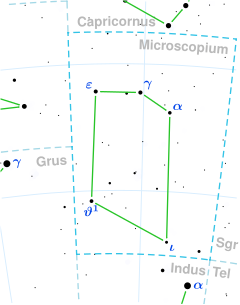HD 198716
| Observation data Epoch J2000.0 Equinox J2000.0 (ICRS) | |
|---|---|
| Constellation | Microscopium |
| Right ascension | 20h 53m 40.18538s[1] |
| Declination | −39° 48′ 35.5092″[1] |
| Apparent magnitude (V) | 5.33±0.01[2] |
| Characteristics | |
| Spectral type | K2 III[3] |
| B−V color index | +1.32[4] |
| Astrometry | |
| Radial velocity (Rv) | 20.1±2.8[5] km/s |
| Proper motion (μ) | RA: +43.548 mas/yr[1] Dec.: −97.023 mas/yr[1] |
| Parallax (π) | 8.2435 ± 0.0774 mas[1] |
| Distance | 396 ± 4 ly (121 ± 1 pc) |
| Absolute magnitude (MV) | −0.1[6] |
| Details | |
| Mass | 2.45±0.12[7] M☉ |
| Radius | 23.9[8] R☉ |
| Luminosity | 160±3[1] L☉ |
| Surface gravity (log g) | 1.41±0.01[9] cgs |
| Temperature | 4,453±122[10] K |
| Metallicity [Fe/H] | −0.04[11] dex |
| Rotational velocity (v sin i) | 2±1.3[12] km/s |
| Age | 622+275 −64[1] Myr |
| Other designations | |
| Database references | |
| SIMBAD | data |
HD 198716, also known as HR 7987 or 33 G. Microscopii, is a solitary star[15] located in the southern constellation Microscopium. Eggen (1993) lists it as a member of the Milky Way's old disk population.[11]
The object has an apparent magnitude of 5.33,[2] making it faintly visible to the naked eye under ideal conditions. Based on parallax measurements from the Gaia satellite, it is estimated to be 396 light years away from the Solar System.[1] However, it is drifting closer with a somewhat constrained heliocentric radial velocity of 20 km/s.[5] At its current distance, HD 198716's brightness is diminished by 0.1 magnitude due to interstellar dust.[16]
This is an evolved red giant star with a stellar classification of K2 III. It has 2.45 times the mass of the Sun[7] but at an age of 622 million years,[1] it has expanded to 23.9 times the Sun's radius.[8] It radiates 160 times the luminosity of the Sun[1] from its photosphere at an effective temperature of 4,453 K,[10] giving it an orange hue. HD 198716 is slightly metal deficient and spins moderately with a projected rotational velocity of 2 km/s.[12]
References[edit]
- ^ a b c d e f g h i Vallenari, A.; et al. (Gaia collaboration) (2023). "Gaia Data Release 3. Summary of the content and survey properties". Astronomy and Astrophysics. 674: A1. arXiv:2208.00211. Bibcode:2023A&A...674A...1G. doi:10.1051/0004-6361/202243940. S2CID 244398875. Gaia DR3 record for this source at VizieR.
- ^ a b Høg, E.; Fabricius, C.; Makarov, V. V.; Urban, S.; Corbin, T.; Wycoff, G.; Bastian, U.; Schwekendiek, P.; Wicenec, A. (March 2000). "The Tycho-2 catalogue of the 2.5 million brightest stars". Astronomy and Astrophysics. 355: L27–L30. Bibcode:2000A&A...355L..27H. ISSN 0004-6361.
- ^ Houk, N. (1982). Michigan Catalogue of Two-dimensional Spectral Types for the HD stars. Volume III: Declinations −40° to −26°. Bibcode:1982mcts.book.....H.
- ^ Johnson, H. L.; Mitchell, R. I.; Iriarte, B.; Wisniewski, W. Z. (1966). "UBVRIJKL Photometry of the Bright Stars". Communications of the Lunar and Planetary Laboratory. 4: 99–110. Bibcode:1966CoLPL...4...99J.
- ^ a b Gontcharov, G. A. (November 2006). "Pulkovo Compilation of Radial Velocities for 35 495 Hipparcos stars in a common system". Astronomy Letters. 32 (11): 759–771. arXiv:1606.08053. Bibcode:2006AstL...32..759G. doi:10.1134/S1063773706110065. eISSN 1562-6873. ISSN 1063-7737. S2CID 119231169.
- ^ Anderson, E.; Francis, Ch. (May 2012). "XHIP: An extended hipparcos compilation". Astronomy Letters. 38 (5): 331–346. arXiv:1108.4971. Bibcode:2012AstL...38..331A. doi:10.1134/S1063773712050015. eISSN 1562-6873. ISSN 1063-7737. S2CID 119257644.
- ^ a b Kervella, Pierre; Arenou, Frédéric; Mignard, François; Thévenin, Frédéric (March 2019). "Stellar and substellar companions of nearby stars from Gaia DR2". Astronomy & Astrophysics. 623 (4): A72. arXiv:1901.09170. Bibcode:2019MNRAS.484.4619G. doi:10.1051/0004-6361/201834371. eISSN 1432-0746. ISSN 0004-6361.
- ^ a b Kervella, Pierre; Arenou, Frédéric; Thévenin, Frédéric (2022). "Stellar and substellar companions from Gaia EDR3". Astronomy & Astrophysics. 657: A7. arXiv:2109.10912. Bibcode:2022A&A...657A...7K. doi:10.1051/0004-6361/202142146. eISSN 1432-0746. ISSN 0004-6361.
- ^ Poggio, E.; Recio-Blanco, A.; Palicio, P. A.; Re Fiorentin, P.; de Laverny, P.; Drimmel, R.; Kordopatis, G.; Lattanzi, M. G.; Schultheis, M.; Spagna, A.; Spitoni, E. (30 September 2022). "The chemical signature of the Galactic spiral arms revealed by Gaia DR3". Astronomy & Astrophysics. 666: L4. arXiv:2206.14849. Bibcode:2022A&A...666L...4P. doi:10.1051/0004-6361/202244361. eISSN 1432-0746. ISSN 0004-6361.
- ^ a b Stassun, Keivan G.; et al. (9 September 2019). "The Revised TESS Input Catalog and Candidate Target List". The Astronomical Journal. 158 (4): 138. arXiv:1905.10694. Bibcode:2019AJ....158..138S. doi:10.3847/1538-3881/ab3467. eISSN 1538-3881. hdl:1721.1/124721. S2CID 166227927.
- ^ a b Eggen, O. J. (July 1993). "Evolved GK stars near the sun. I - The old disk population". The Astronomical Journal. 106: 80. Bibcode:1993AJ....106...80E. doi:10.1086/116622.
- ^ a b De Medeiros, J. R.; Alves, S.; Udry, S.; Andersen, J.; Nordström, B.; Mayor, M. (January 2014). "A catalog of rotational and radial velocities for evolved stars". Astronomy & Astrophysics. 561: A126. arXiv:1312.3474. Bibcode:2014A&A...561A.126D. doi:10.1051/0004-6361/201220762. eISSN 1432-0746. ISSN 0004-6361.
- ^ Gould, Benjamin Apthorp (1878). "Uranometria Argentina : brillantez y posicion de las estrellas fijas, hasta la septima magnitud, comprendidas dentro de cien grados del polo austral : con atlas". Resultados del Observatorio Nacional Argentino. 1. Bibcode:1879RNAO....1.....G.
- ^ "HD 198716". SIMBAD. Centre de données astronomiques de Strasbourg. Retrieved November 24, 2022.
- ^ Eggleton, P. P.; Tokovinin, A. A. (11 September 2008). "A catalogue of multiplicity among bright stellar systems". Monthly Notices of the Royal Astronomical Society. 389 (2): 869–879. arXiv:0806.2878. Bibcode:2008MNRAS.389..869E. doi:10.1111/j.1365-2966.2008.13596.x. eISSN 1365-2966. ISSN 0035-8711.
- ^ Gontcharov, George A.; Mosenkov, Aleksandr V. (28 September 2017). "Verifying reddening and extinction for Gaia DR1 TGAS main sequence stars". Monthly Notices of the Royal Astronomical Society. 472 (4): 3805–3820. arXiv:1709.01160. Bibcode:2017MNRAS.472.3805G. doi:10.1093/mnras/stx2219. eISSN 1365-2966. ISSN 0035-8711.

